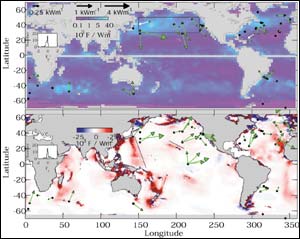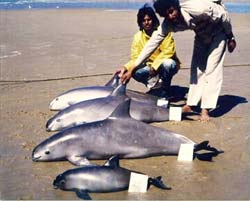
When internal waves up to 300 feet first form they cause a mighty churning of ocean waters – something invisible to and unfelt by anyone at the surface.
Now in a novel use of mooring data, some of it three decades old, a University of Washington researcher has calculated just how much punch these waves appear to carry as they travel, or propagate, thousands of miles from where they originate.
It’s energy that appears to be crucial to the conveyor-belt-like circulation wherein m

Lawrence Berkeley National Laboratory (Berkeley Lab) scientists have developed the world’s first x-ray computed tomography (CT) scanner capable of examining entire core samples at remote drilling sites. The portable device, which employs the same high-resolution imaging technology used to diagnose diseases, could help researchers determine how to best extract the vast quantities of natural gas hidden under the world’s oceans and permafrost.
The scanner images the distribution of gas hydrate
A NASA robotic geologist named Spirit began its seven-month journey to Mars at 1:58:47 p.m. Eastern Daylight Time (10:58:47 a.m. Pacific Daylight Time) today when its Delta II launch vehicle thundered aloft from Cape Canaveral Air Force Station, Fla.
The spacecraft, first of a twin pair in NASA’s Mars Exploration Rover project, separated successfully from the Delta’s third stage about 36 minutes after launch, while over the Indian Ocean. Flight controllers at NASA’s Jet Propul
The amount of gaseous mercury in the atmosphere has dropped sharply from its peak in the 1980s and has remained relatively constant since the mid 1990s. This welcome decline may result from control measures undertaken in western Europe and North America, but scientists who have just concluded a study of atmospheric mercury say they cannot reconcile the amounts actually found with current understanding of natural and manmade sources of the element. An international group of scientists, led by

Defying ocean’s end offers global perspective on eve of pew report
For the first time ever, the world’s largest environmental organizations, working with scientists, the business community and international governments, met specifically to develop a comprehensive and achievable agenda to reverse the decline in health of the world’s ocean.
The five-day Defying Ocean’s End (DOE) conference marked the launch of a new, science-based international effort to restore and maintain
The EU examines ways to reverse damage in the Mediterranean and Black Seas
Fifty years of intense development and exploitation have resulted in significant change to the fragile natural resources of the Mediterranean and Black Seas, and their coastal areas. Agreeing ways to prevent further environmental degradation will be the focus of the “International Conference on the Sustainable Development of the Mediterranean and Black Sea Environment” (IASON), to be held from 28 May to 1June i